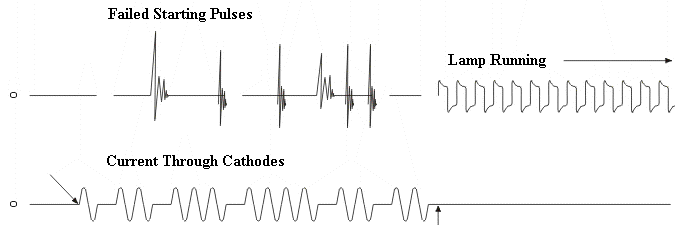NORDTEK DANMARK - Advantages and Theory of the TubeSaver - servicekontoret.dk
Advantages and Theory of the TubeSaver
A DETAILED DESCRIPTION OF THE THEORY BEHIND THE TUBESAVER
The life of a fluorescent lamp is dictated by the life of it's cathode filament assemblies. These filaments are similar to those, which glow, in an ordinary light bulb to give light, but their purpose is different. In a fluorescent lamp the filaments -have been immersed in a paste, rich in rare earth compounds, which dries to form an impregnating coating over the filament coils.
In operation the filaments are heated, causing the rare earth compounds to emit electrons. When the lamp cathode coating is all used, there can be no more electron emission and the lamp ceases operation.
Exhaustion of the cathode emissive material is the reason for almost all lamp failures and lamp cathodes, therefore, hold the key to lamp life.

When a lamp is running, only a small amount of material is constantly consumed.
When a lamp is started by a flicker - starter, large amounts of material are dislodged from the cathodes - often the equivalent of over a full day of normal operation.
A lamp, which is never switched, will operate for a very long time indeed, whereas a lamp, which is, switched frequently by a glow starter will have a short life.
- In a switch start circuit lamp ignition is achieved by closing the starter contacts and allowing current to flow from the choke through the two cathodes to warm them to emission temperature.
Through this process - known as "thermionic emission" - the status of the gas changes, from insulator to conductor, as more and more electrons are released.
If, when sufficient electrons have been released by the cathodes, the starter contacts open, a starting pulse generated across the tube will cause an avalanche of electron activity and create an electrical discharge between the ends of the lamp.
Electron collisions in this "lamp arc" release invisible ultra violet light energy, which is converted to visible light by the phosphor powder coating on the inside of the tube wall.
Unfortunately for the lamp started with a glow starter, the process of starting is very haphazard. The sequence of events is as follows:
Upon switch on, the voltage across the unlit tube is at mains input potential. This causes the gas in the glow bottle to glow, heating a bi-metallic strip which moves to short circuit the switch contacts and allows pre-heat current to flow through the cathodes.
The glow is extinguished by the short-circuiting of the starter contacts and the bi-metal cools rapidly, causing the contacts to separate, which releases the stored energy in the ballast and generates a high voltage pulse across the lamp.
This pulse may not be at a good point in the mains cycle and the switch may not have been closed for long enough to fully pre-heat the cathodes.
The first pulse, therefore, may not strike the lamp and the cycle repeats itself.
This cycle of a little heating and a random pulse occurs several times each second until:
(a) The cathode has achieved a long enough heating time to achieve thermionic emission and (b) A corresponding pulse is released at a good point in the mains cycle. The lamp will then ignite. When the lamp is running the voltage across the lamp, and hence the starter, reduces to a level too low to excite a glow discharge in the starter bottle, which then remains inactive.

The problem with this system is that many pulses can be applied which does not ignite the lamp, because the cathodes have not been heated sufficiently. The great instantaneous power in these pulses has to be dissipated.
Pulse energy cannot discharge into the lamp gas, as this is still insulating, so the energy has to be dissipated by the lamp cathode filaments.
The high energy finds weak spots on the cathode, concentrating power onto a single point.
Resultant "explosions" blast away the rare earth emissive compound from the cathodes and onto the cathode shield or tube wall.
This is visibly apparent as tube end blackening.

When the starting action has removed too much emissive material in this way, the lamp ceases to operate.
Just a few decades ago phosphor-gas and mercury dosing technology was such that a tube had lost up to 30% of it's light output within 10,000 hours of operation, after which time the light output dropped ever more sharply. To extend the electrical life of the lamp was therefore pointless as it was economically necessary to replace lamps at around the 7,500 hours mark in order to maintain good lumen levels.
As the glow flicker starter had very low cost and yet allowed lamps an electrical life of between 5,000 and 8,000 hours in an average installation - the same as their useful light output life - it was an acceptable solution at the time.
In the last decades, however, very major advances have been made in the area of phosphor technology, gas filling, general purity and levels of mercury dosing. These have resulted in very dramatic changes in modern fluorescent lamp light output maintenance, such that current generation lamps lose less than 5% of lumen output over more than 20,000 hours of burning; and thereafter remain virtually stable.
Clearly, a starter system which, by it's very design, destroys lamps within 5 - 8,000 hours - only 25% of their life potential - has no place for use with today's lamps.
This is the reason for the development of the TubeSaver system.
TubeSaver can be directly plugged in, in place of a glow starter, in any application, and allows fluorescent tubes to always achieve their very maximum life, regardless of switching cycles.
When switching on a lamp with the TubeSaver system, cathodes are heated continuously at low voltage until they reach full emission temperature. The time is automatically adjusted by the starter according to conditions. At the end of the pre- heating period the cathodes will be emitting freely over their entire area and a low energy, impulse is then delivered across the tube to achieve ignition.

Due to the complete pre-heating and low energy pulse, the cathodes suffer no measurable wear during the start cycle and the lamps burn for as many hours as if they were operated continuously without re-starting.

Once the lamp is running a safety monitor comes into action, constantly measuring the power taken by the lamp. In the event of an abnormality, as can occur when a ballast starts to fail, or with major supply irregularities, or at the end of lamp life, TubeSaver's safety monitor will disconnect the circuit until the fault is corrected.
Apart from the financial advantages from the longer lifespan of the lamps, the comfort of being free from the unnecessarily blinking tubes and the safety function, it is also pleasant to think that our environment is saved from a considerable amount of mercury and other heavy metals.
For the foreseeable future fluorescent lamps will remain as the number one choice for the most efficient and comfortable light source for commercial, industrial and other large area illumination applications, as well as for areas in the home requiring good levels of uniform light.
With TubeSaver the very maximum economic benefit is achieved at the very lowest environmental cost.
See Introduction to TubeSaver here
See Compatibility Chart here
Top of page






